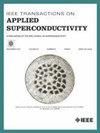无绝缘高温超导线圈临界电流测量分析
IF 1.8
3区 物理与天体物理
Q3 ENGINEERING, ELECTRICAL & ELECTRONIC
引用次数: 0
摘要
研究无绝缘(NI)高温超导(HTS)线圈的电磁特性对于推进高温超导在能源、医疗和交通等许多领域的应用至关重要。本文对直径为367.6 mm的NI高温超导线圈进行了充电过流试验和突然放电试验,得到了该线圈的电磁参数。研究发现,NI HTS线圈在测试过程中产生的显著径向电流会使拟合的线圈电压和电源电流曲线与E-J幂律特性产生明显偏差,从而导致测量的临界电流(Ic)和n值出现显著误差。为了解决这个问题,在测量Ic和n值时考虑了径向电流的影响,从而能够精确确定这些值。同时,建立了基于T-A公式的NI高温超导线圈有限元模型,模拟了线圈运行过程中的瞬变电磁行为。此外,研究了不同孔径的NI高温超导线圈和不同接触电阻率的高温超导线圈在斜坡过程中的电流分布,并分析了不同因素对Ic和n值测量的影响。研究结果为NI高温超导磁体系统的性能评价和设计优化提供了理论依据。本文章由计算机程序翻译,如有差异,请以英文原文为准。
Analysis of Critical Current Measurement for No-Insulation HTS Coil
Investigating electromagnetic characteristics of no-insulation (NI) high-temperature superconducting (HTS) coils is critical for advancing the use of HTS in many areas, such as energy, medical, and transportation. In this article, the charging and overcurrent test and the sudden discharging test are carried out on a 367.6-mm diameter NI HTS coil to obtain the electromagnetic parameters. It is found that significant radial current generated in the NI HTS coil during testing will cause obvious deviations between the fitted coil voltage and power supply current curve and the E–J power law characteristics, resulting in significant errors in the measured critical current (Ic) and n-value. To address this issue, the influence of radial current is considered in measuring Ic and n-value, thus enabling the precise determination of these values. Meanwhile, a finite-element model based on the T–A formulation has been developed to model NI HTS coils and simulate transient electromagnetic behavior during coil operation. Furthermore, the current distribution in NI HTS coils with different aperture sizes as well as in HTS coils with different contact resistivities during the ramp process is investigated, and the effects of different factors on Ic and n-value measurement are analyzed. The results provide theoretical foundations for performance evaluation and design optimization of NI HTS magnet systems.
求助全文
通过发布文献求助,成功后即可免费获取论文全文。
去求助
来源期刊

IEEE Transactions on Applied Superconductivity
工程技术-工程:电子与电气
CiteScore
3.50
自引率
33.30%
发文量
650
审稿时长
2.3 months
期刊介绍:
IEEE Transactions on Applied Superconductivity (TAS) contains articles on the applications of superconductivity and other relevant technology. Electronic applications include analog and digital circuits employing thin films and active devices such as Josephson junctions. Large scale applications include magnets for power applications such as motors and generators, for magnetic resonance, for accelerators, and cable applications such as power transmission.
 求助内容:
求助内容: 应助结果提醒方式:
应助结果提醒方式:


